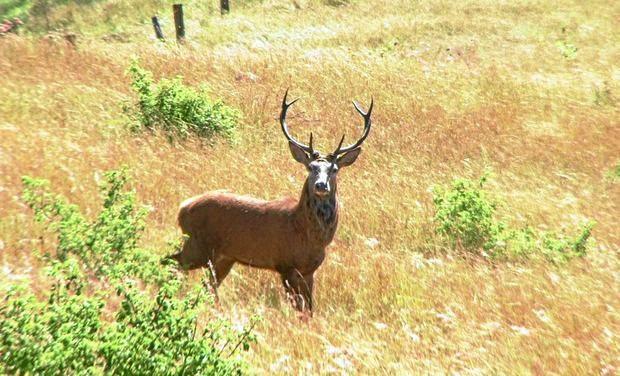Why tackling feral deer plague is not so simple
Concerns are being raised after a vehicle was wiped out by a deer.

Coffs Harbour
Don't miss out on the headlines from Coffs Harbour. Followed categories will be added to My News.
WELL aware of the risk that feral deer pose to motorists, Rockhampton Regional Councillor Ellen Smith has shed light on council's response to the problem.
As chair of Rockhampton Regional Council's Planning and Regulatory Committee, Cr Smith heads up the council's response to the feral pests and she confirmed council was working closely with the Queensland Parks and Wildlife Service to find a solution.
"Only last week, Rockhampton Regional Council convened a round table meeting with QPWS and our neighbours, Livingstone Shire Council to discuss options, and find a way forward," Cr Smith said.
"The infested area is expanding from the National Park areas of Norbank and Nerimbera to the urban area of Lakes Creek and Koongal in Rockhampton, and the rural areas of Livingstone Shire.
"The deer are moving between the National Park and the river for water."
READ: Early morning drive to work costs Anthony deerly

She said most of the deer in the urban areas were on private property, or on land controlled by the park service, so council's involvement was limited.
The issue was further complicated by jurisdiction issues between the State Government and council.
"Feral deer are hard to trap, as they are not used to walking into yards, although traps have been set over time with limited success," she said.
"The animals are proving to be intelligent, and nowhere near as easy to trap as feral pigs. The dense foliage cover of the National Park poses logistical issues for aerial culling programmes.
"A planned cull a few years ago on private property was aborted because of mixed views in the community, and judging by social media comments over the weekend, there are still differing views.
"All wild animals are hungry and thirsty at the present time, due to the ongoing drought, which most people recognise as the worst they have experienced."
Through council's efforts, she said Queensland Transport had installed warning signs to help warn drivers of the potential of deer crossing the road.
Given that feral deer could multiply at a prodigious rate, having two babies every three years, Cr Smith said almost all Queensland local councils were grappling to find a solution for the same issue.
"Even councils that are well resourced are not trapping very many," she said.
"I attended a Pest Animal and Pest Plant Conference at the Gold Coast a few months ago, and believe me, the problem is everywhere.
"Even in heavily populated areas like the Gold Coast are trying to trap them with state-of-the-art traps."
Cr Smith strongly urged the public to report any deer sightings to council on 1300 225 577 or visit feralscan.org.au or download the app which reports sightings of all wild animals directly to State Government departments.
The Morning Bulletin asked readers whether culling was the best solution to address the danger posed to motorists created by the feral deer.
Craig Andrews: They are an introduced pest. (There) should be cull.
Ros Lacey McClintock: I support a cull of all feral animals especially in the dry times when our native animals are struggling to find food and water.
Nicacia Owens: No animal deserves to be killed just because us humans can't be more careful. This world is so cruel.
Brandon Pershouse: As I said the other day cull them but do it smartly. Create a tourism market for this. Set up a place for recreational hunters. Let the council charge them like $50 a day for hunting. The local economy would benefit greatly from this.
Rachael Simpkins: Better lighting in the area is needed. I drive this stretch regularly and there are plenty of deer at all times of the day and night.
James Grose: They're a pest and should be treated as such,although letting shooters manage the population could also be viable.. Mmmmm venison.
Joby Finlay: No I do not support it. It's like any animal that is not locked up.
Damien Scott: 100 per cent they need to be culled anyone who disagrees clearly have not seen the damage they cause not only the cars but also vegetation.
Laura Stanley: No thanks. Keep the deer. Just be more cautious on the roads.
Trent Griffiths: It doesnt matter day or night they are always there as I travel that road every day.
Donna Stenhouse: I live in the area and as I said before it is only a matter of time before someone is killed they are feral and it's like sometimes 10at once darting across the roads and should be better signage until it's sorted what to do....they can be so unpredictable...... they are a pest in our yards as well.....not bambi some people's say........be real it's dangerous and a couple of cars a week written off.
Kim Patriciano: We are in their territory slow down - why do humans want to kill everything when we are the ones invading.
Step Holden: No. Would they also then be intending to cull everything else that people run over? Early morning travelling one can be cautiously driving on the look out for roo's etc and clowns will fly pass as if they don't give a crap about themselves, their vehicles or others on the road. Other road kill out number deer kills many thousands to one but one doesn't hear councillors prattling on about that, do you?
Debra Callaghan: No thanks just be more vigilant on our roads.
Sharon Attard: Just slow down and keep safe.
Originally published as Why tackling feral deer plague is not so simple


